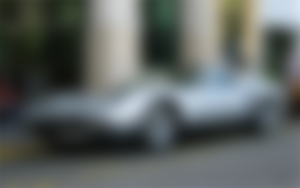At the beginning of the 1960s, Ferrari had already dominated the international car scene for twenty years, thanks above all to the sporting triumphs of its driving champions (Tazio Nuvolari, Juan Manuel Fangio and Alberto Ascari). At that time (1963), twenty kilometres north of Maranello (Ferrari's historical headquarters), in the small town of Sant'Agata Bolognese Ferruccio Lamborghini founded his car company. Lamborghini, after collecting successes and billions of liras manufacturing tractors, decided to focus on the sports car sector, launching the challenge to the nearby Ferrari. The idea had come to him after a discussion with Enzo Ferrari, to whom he had suggested how to improve some of the flaws revealed by his machines, feeling abruptly liquidated, reminding him that he was a tractor manufacturer, he decided to build a high level and ultra-modern sports car. So at least he wants the legend endorsed by himself.

Three young engineers (Gian Paolo Dallara, Paolo Stanzani and Giotto Bizzarrini) working at record-breaking speeds created the prototype of the first Lamborghini in less than a year: a coupé with a 12-cylinder engine, four overhead tube axles, 3.5-litre displacement and 360 hpThe Miura, the four independent wheels. Designed by Franco Scaglione, it was called 350 GTV and was presented at the Turin Motor Show. The Touring production model made its debut in Geneva in 1964. Speed and daring were Lamborghini's watchwords: in 1965 the sensational P400 chassis was presented in Turin for a sports car in which the V12 was rear and transversal: a stroke of genius by Dallara, who had intuited the great possibilities of this solution for a revolutionary GTV. Bertone began a twenty-year collaboration and created the beautiful Miura (from a race of fighting bulls). Lamborghini was born under the sign of the bull and names of bulls are still adopted today. The Miura debuted in Geneva in '66; this saloon was often a springboard for new models: the Marzàl in '67, a futuristic 4-seater coupé with a 6-cylinder rear engine; the Espada coupé in '68, Jarama in '70. The following year here is the prototype LP 500 Countach: the letters mean Longitudinal Rear, to indicate that the Miura solution had been abandoned, the number referred to the 5-litre displacement. Countach in Piedmontese means “wow!” and, it is said, was the exclamation of Nuccio Bertone when he saw the car.

With subsequent modifications and variations, it remained alive until 1989. The recurring economic crises convinced Lamborghini to accept a partner (the Swiss Rossetti) and then to leave. The first period of the company's life ended in 1971. The second, until mid-1998, was the most troubled, with many changes of ownership. However, there was no lack of interesting models. From the 1970 Urraco type derived a four-seater series with the rear V8 engine; in 1986 the fastest off-road in the world was produced: LM 002. And also marine engines that continue to win offshore. In 1990 the 4-wheel drive Diablo was produced with 11 variants until 2000. The design of the new models was supervised for years by Marcello Gandini. By Giorgetto Giugiaro la Cala and the brand new Gallardo. After the first Swiss owner and a confusing period with various purchase attempts culminating in the company's bankruptcy and auction, other vicissitudes and a twist that promised good news: in 1987 Chrysler bought Lamborghini promising not only an industrial relaunch but also entry into Formula 1. This happened with the arrival of Mauro Forghieri, former Ferrari. The programme took off, Lamborghini engines powered the Lola Larrousse (even reaching points). But in 1993 Chrysler retired, giving in to an Indonesian group that in turn, hopefully, the then No. 1 Di Capua who sold the company to Audi. In June 1998 began the third period in the history of this brand, which has carved out a place for itself in the Olympus of supercars. The German group carried out a major renovation of the plant under the direction of Giuseppe Greco. In 2001 it launched the Murcielago model and this year, to celebrate its fortieth anniversary, a "discovery" derived from the same model was proposed at the Detroit Motor Show. The latest great novelty was the Gallardo, presented in Geneva, with a rear V10 engine, all-wheel drive and aluminium structure. A name, obviously Spanish, from bull to the more recent Huracán.



